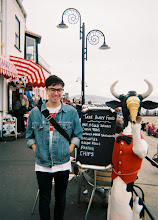Everything's been handed in now so, until the viva, I suppose that this project is over. I do intend to carry some ideas through to my next project but in the meantime I think its time to evaluate this project, exploring what it is I have learned and what it is I would improve upon, were I given the time.
Firstly, learning outcomes. I think I have actually learnt quite a lot from this project, chiefly is the experience that I gained from using the Bronica, the first time I've used a 'proper' medium format camera (as opposed to the Holga). Early on I decided to use high-iso film and that has been a choice that has paid off. Not only did the fast iso allow me to capture images in particularly low-lighting situations, it gave me the grain, (which was the real reason for my choice), and gave a particularly good texture to skin-tones which would otherwise have appeared a little plain. As well as this I feel much more confident in using Photoshop as a tool to lightly manipulate images, such as using the levels etc. to make images a little clearer, as well as more major work with things like the selection tool, which allowed me to shift about the various quadrants of my Polaroid images.
If I had more time for this project I would have liked to further refine my final images, either choosing to shoot solely in black and white or colour, most likely black and white as I felt that these images captured a more distilled sense of 'looking' at a specific subject. I would also have liked to pick a single final strand to follow, whether to leave clues of identity through small idiosyncratic details in minor clothing or to completely erase any clues as to the identity of the person and have the study of their body being the sole focus I am still unsure.
Until the next project when I hope to further pursue these avenues of investigation, Goodbye.


